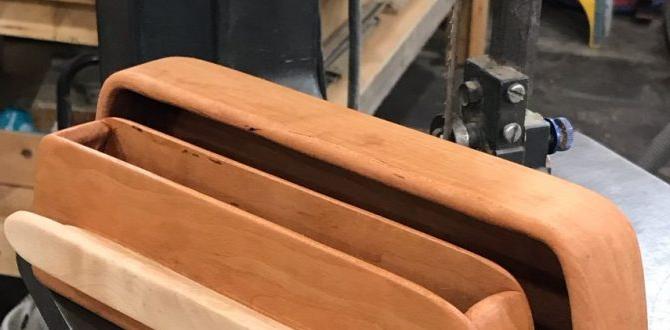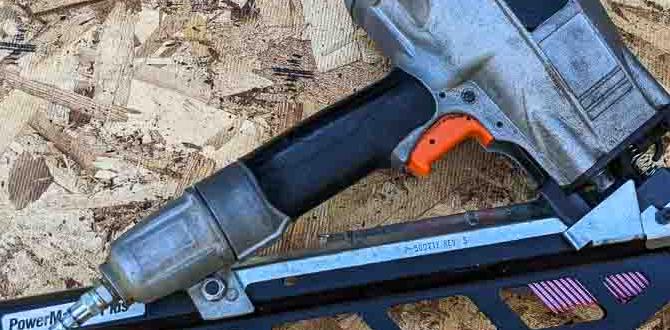Convert your pneumatic nailer to cordless for ultimate freedom and ease! Learn simple, effective methods to ditch the compressor and hose, making your DIY projects smoother and more efficient. Get ready for a tangle-free nailing experience.
Hey there, fellow DIYers and woodworking enthusiasts! Jack Shaffer here from Nailerguy. Ever found yourself wrestling with an air hose, tripping over the compressor, or just wishing for a bit more freedom while you’re nailing? If you’ve got a trusty pneumatic nailer but crave the portability of a cordless tool without buying a whole new one, you’re in the right spot. It might sound like a big leap, but converting your air-powered nailer to a battery-operated wonder is more achievable than you think, and it dramatically ups your efficiency and convenience on any job. We’ll walk through how to make this happen, step by step, so you can tackle projects with newfound agility. Let’s get your nailer untethered!
Table of Contents
Why Go Cordless? The Perks of Untethered Nailing
Let’s face it, pneumatic nailers pack a punch. They’re powerful, reliable, and often more budget-friendly upfront. But that air compressor and hose? They can really cramp your style. Imagine framing a deck, building a fence, or even just hanging some trim without lugging a heavy compressor or constantly managing that whip-like hose. That’s where going cordless shines.
Here’s what you gain by making the switch:
- Unmatched Portability: Move around your worksite or home freely. No more running hoses through doorways or dealing with kinks.
- Faster Setup: Grab your tool and go! Setup time is drastically reduced when you don’t have to connect air lines and start a compressor.
- Cleaner Workspaces: Less equipment means fewer trip hazards and a tidier job site.
- Consistent Power: Modern cordless nailers offer impressive power and consistent performance, rivaling their pneumatic counterparts.
- Quiet Operation: Many cordless models are significantly quieter than a constantly running compressor.
The desire to ditch the cord and compressor is a common one, especially as battery technology continues to improve. It transforms how you approach a project, making it less of a chore and more of a seamless experience. But how exactly do you bridge the gap between your current air-powered workhorse and the freedom of a cordless setup? That’s what we’re diving into.
Understanding the Tech: Pneumatic vs. Cordless Nailers
Before we jump into the conversion, it’s helpful to understand the basic differences between the two types of nailers.
Pneumatic Nailers: These tools use compressed air to drive nails. A compressor stores air under pressure, and when you pull the trigger, that air is released rapidly through a hose to power a piston that drives the nail. They require a continuous supply of air to function.
Cordless Nailers: These operate on either a battery-powered motor with an internal air/gas mechanism or a direct electric drive. Many modern cordless nailers use advanced battery technology and miniature on-board compressors or gas cartridges to achieve powerful nail driving without external air. Lithium-ion batteries are the standard, offering good power and longevity.
The core challenge in converting a pneumatic nailer is replicating that rapid burst of compressed air or the mechanical force that drives the nail, all without the external compressor.
Methods for Going Cordless: The “Conversion” Explained
Now, let’s get to the heart of it. When we talk about “converting” a pneumatic nailer to cordless, it’s usually not about physically modifying the existing pneumatic tool itself to run on batteries. That would involve a massive engineering overhaul, replacing all the air-driven components with motors, pistons, and battery systems. It’s highly impractical for a DIYer and generally not possible to achieve safely or effectively.
Instead, the genius and effortless way to achieve a “cordless conversion” for your pneumatic nailer is to understand that you’re essentially replacing the pneumatic nailer with a new cordless nailer that serves the same purpose. Think of it less as a modification and more as an upgrade in portability and convenience.
However, there are a few ways people interpret “conversion,” and some DIY enthusiasts might explore more intricate (and often less practical) routes. Let’s look at the common approaches:
Approach 1: The Most Practical Upgrade – To a Dedicated Cordless Nailer
This is by far the most common, simplest, and most effective way to gain cordless capability. You’re not truly “converting” your old pneumatic nailer, but rather embracing the cordless revolution by purchasing a dedicated cordless version of the nailer you need.
How it works: You buy a brand-new cordless nailer designed to do the same job as your pneumatic one (e.g., a cordless framing nailer if you have a pneumatic framing nailer, or a cordless brad nailer for finish work).
Pros:
- Engineered for cordless operation – maximum efficiency and power.
- Widely available in various types (framing, finishing, roofing, etc.).
- Reliable and safe as designed by the manufacturer.
- Often come with excellent warranties.
- Easy to use: charge battery, load nails, and go.
Cons:
- Requires purchasing a new tool.
- Can be more expensive upfront than pneumatic tools and compressors.
Approach 2: Portable Air Systems – A Partial Solution
This method doesn’t make your nailer cordless, but it makes your air source portable, essentially untethering you from a large, stationary compressor.
How it works: You use small, portable air compressors that run on batteries or can be plugged into car outlets. Some are designed to be carried easily. You still connect your pneumatic nailer via a hose to this portable unit.
Pros:
- Allows you to keep using your existing pneumatic nailer.
- Offers more portability than a traditional compressor.
- Good for tasks where a few dozen nails are needed without dragging out the big stuff.
Cons:
- Still requires a hose and the portable compressor unit.
- Battery life can be limiting.
- May not provide the same consistent pressure or CFM (Cubic Feet per Minute) as a larger compressor for high-demand tasks.
- Can be noisy.
When this might work: If you only occasionally need portability for a pneumatic nailer and don’t want to invest in a new cordless tool, a portable air system is a middle-ground option. However, for genuine “cordless freedom,” a dedicated cordless nailer is superior.
Approach 3: DIY Battery Conversion – Highly Cautionary and Rare
This is where the idea of “converting your pneumatic nailer to cordless” might originate, but it’s extremely complex, potentially dangerous, and generally not recommended for DIYers. It involves attempting to retrofit a battery-powered system (motor, battery, electronics) into the body of an air-powered nailer to mimic the firing mechanism.
How it would theoretically work: A skilled engineer or advanced maker might attempt to replace the air cylinder with an electric motor and a cam or solenoid system that can strike the nail head with enough force. This would also require integrating a battery pack and control circuitry.
Pros:
- Potentially repurposes existing tools (for the very ambitious).
Cons:
- Extremely Difficult: Requires advanced knowledge of electronics, mechanics, and power systems.
- Dangerous: Improperly handled high-voltage batteries or powerful motors can cause serious injury.
- Inefficient: The power-to-weight ratio is usually very poor compared to purpose-built cordless tools.
- Unreliable: Likely to break down often and provide inconsistent performance.
- Voided Warranties: Destroys any manufacturer warranty on the original tool.
- Costly: The components needed can be expensive, often exceeding the cost of a new, purpose-built cordless nailer.
My Advice: As Jack Shaffer, your Nailerguy, I strongly advise steering clear of this path. The risk, complexity, and poor results far outweigh any perceived benefit. The “genius” and “effortless” aspect of this conversion truly lies in choosing the right tool for the job from the start, which in this case, means getting a purpose-built cordless nailer.
Choosing Your Cordless Nailer: The Smart Upgrade
Since Approach 1 (buying a dedicated cordless nailer) is the most practical and effective way to achieve the “cordless conversion” dream, let’s talk about how to choose the right one. Think about what you primarily use your pneumatic nailer for.
| Nailer Type | Typical Use Cases | Cordless Features to Look For |
|---|---|---|
| Framing Nailer | Building house frames, decks, larger structures, fences. Drives larger nails (2.5″ – 3.5″). | High power, consistent drive depth, sequential or contact fire mode, good balance for heavy lifting. Battery voltage (18V, 20V MAX, 40V) is important here. |
| Finish Nailer (15 & 16 Gauge) | Installing trim, crown molding, baseboards, cabinet installation. Drives finishing nails (1.25″ – 2.5″). | Compact size, good ergonomics, excellent depth adjustment, clean firing with minimal marring. Often 18V or 20V MAX. |
| Brad Nailer (18 Gauge) | Attaching small trim, delicate moldings, craft projects, cabinetry details. Drives very small nails (0.75″ – 1.25″). | Lightweight, precise, often very slim nose for tight spots. 18V or 20V MAX. |
| Pin Nailer (23 Gauge) | Attaching delicate trim, small miter joints, craft work where the nail head needs to be invisible. Drives headless pins. | Super-fine nose, lightweight, good for precision. Typically 18V or 20V MAX. |
| Roofing Nailer | Installing asphalt shingles. | Durable, weather-resistant, consistent nail depth without penetrating shingles. Often higher voltage or specialized battery systems. |
Key Features to Consider in Cordless Nailers
When you’re looking at cordless options, keep these features in mind to ensure you get a tool that’s truly a joy to use.
- Battery System Compatibility: Are you already invested in a brand’s cordless tool ecosystem (e.g., DeWalt 20V MAX, Milwaukee M18, Ryobi 18V ONE+)? If so, sticking with that brand can save you money on batteries and chargers.
- Power Source Technology:
- Battery + Motor (e.g., “Air-Free”): These tools have an electric motor that drives a piston, simulating the action of an air nailer. They’re the most common and offer great performance for most tasks.
- Battery + Gas Cartridge: Some tools use a battery to ignite a small burst of fuel from a disposable propane or butane cartridge. This offers high power but requires ongoing fuel costs and ventilation. Less common in newer models.
- Drive Depth Adjustment: Crucial for sinking nails to the right depth without damaging the wood or leaving them proud. Look for easy-to-use dials or levers.
- Sequential vs. Contact Fire:
- Sequential (Single Fire): Press the nose to the surface, then pull the trigger. This is safer and more precise.
- Contact Fire (Bump Fire): Hold the trigger down and “bump” the nose against the surface to drive nails rapidly. Great for speed but requires more control. Many tools offer both modes.
- Weight and Ergonomics: You’ll be holding this tool. A lighter, well-balanced tool with a comfortable grip will make a huge difference, especially during long jobs.
- Depth of Drive Settings: Essential for sinking nails to the perfect depth. Adjustable settings are a must-have.
- Jam Clearing: How easy is it to clear a jammed nail? Tool-free jam clearing is a huge convenience.
- LED Work Light: Handy for illuminating your work area, especially in dimly lit spaces.
Popular Cordless Nailer Brands (and their systems)
Many reputable tool manufacturers produce excellent cordless nailers. Here are a few examples:
- DeWalt: 20V MAX and FLEXVOLT systems. Known for robust performance and wide tool selection.
- Milwaukee: M18 and MX FUEL systems. High-power, professional-grade tools.
- Ryobi: 18V ONE+ and 40V systems. Great value, large ecosystem of tools.
- Metabo HPT (formerly Hitachi): 18V MultiVolt system. Offers strong performance and innovative battery designs.
- Bostitch: 18V and 20V MAX systems. A long-standing name in fastening.
- Senco: Fusion and Line of cordless nailers. Specializing in fastening solutions.
The Simple Steps to Cordless Freedom (The “Conversion” Process)
Ready to experience the joy of cordless nailing? Here’s the clear, actionable guide for the most effective “conversion.”
-
Step 1: Assess Your Needs
Think about the types of projects you do most often. Which pneumatic nailer do you reach for the most? Framing, finishing, brad nailing? This will dictate the type of cordless nailer you need.
-
Step 2: Research Cordless Options
Based on your needs, start looking at dedicated cordless nailers in that category. Read reviews from other DIYers and professionals. Check out comparisons and watch demonstration videos.
Consider which battery platform makes the most sense for you. If you already own tools from a certain brand, sticking with that platform can be a significant cost saver. For more information on tool battery standards, you can check out resources like those from the EnergySage guide to lithium-ion battery technology, which explains the core power source.
-
Step 3: Make the Purchase
Once you’ve decided on a model and brand, make your



